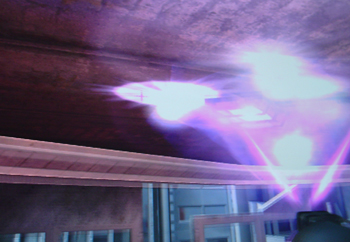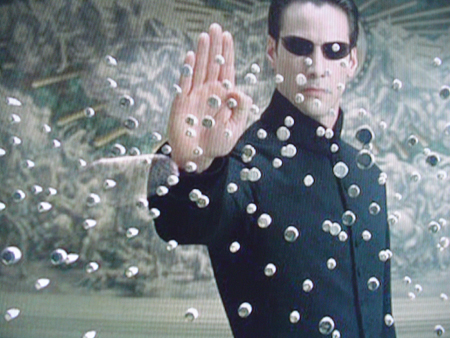A Guide to Choosing the Right 19" LCD Monitor - 7 Models Reviewed
by Kristopher Kubicki on November 30, 2004 12:04 AM EST- Posted in
- Displays
Application Analysis
The core of our LCD benchmarking comes from real application analysis. We play with a lot of monitors and it gets easier for us each time to pick out problems with an LCD just by using the right application. Here are a few quick looks at some demanding full screen applications. We already ran ColorVision's OptiCal software, so all of our monitors are calibrated and adjusted to the same curves.High Definition Video - We cheated a little bit on this portion of the analysis and handicapped all the monitors. None of these LCDs can display a true HD signal correctly without compressing pixels or cropping the image. Nevertheless, we set out to play a WMV9 1080i signal on our monitors with the interest in looking for color differences. Since our monitors have all been precalibrated, we expect the same image on each screen. Unfortunately, no amount of calibration can fix some things; we still noticed "off" reds on most of the monitors (including the Samsung 193P, the Sony, the Planar and the Dell). The BenQ, NuTech and ViewSonic occasionally managed to wash out blues a little too easily, and when looking in the right places, we could easily spot some of the differences between the 6-bit BenQ image.
The Matrix Reload, The Matrix - We use the Matrix series to test full motion video on our LCDs. Since the Matrix isn't the best movie to test color reproduction, we typically only look for motion blur or other imperfections. As expected, we noticed no fatal flaws in any of the LCDs. Although, while running some of them side by side, it became readily apparent that some monitors put a slight hint of color on the application - noticeably, the NuTech and ViewSonic monitors had a slight bluish tint.
WarHammer 40K, Dawn of War - When looking for a monitor's response time, we generally only consult first-person shooters for reference. However, those of you who have played a fast-paced game of Warcraft III or NeverWinter Nights will know that scrolling around for hours puts a severe tax on the monitor. Although we didn't notice any profound difference on the 16ms BenQ monitor, we could tell that the Sony and Planar had occasional difficulty in poorly lit areas of the game. For example, when scrolling around the last level of DOW where the majority of the level is gray ash and black soot, we would see the edge of the menu bar and status icons bleed into the ground.
Looking closer, we noticed some small differences with heavy weapons fire while scrolling on the BenQ FP931 and Samsung 193P. With enough patience, we can actually count the tracers shot over long distances, but when viewing the same scene on the Planar PE191M, the same task seems almost impossible. Attempting to do the same on the ViewSonic LCD proves futile sometimes, but not others.
Max Payne 2 - The extreme light and dark transitions in Max Payne still provide us with the sufficient criteria to benchmark transient response time; specifically, we can focus on the light and dark extremes. However, in all of the demos that we ran, we noticed virtually no difference from one monitor to another. The Samsung 193P looked a little more vibrant than its competitors, but the NuTech and ViewSonic models were displaying particularly brighter lights while maintaining the same dark hues as the SyncMaster 193P. Revisiting Max Payne with the Dell 2001FP was a little bit of a surprise. Even with the brightness set to its maximum, we were a little surprised at how much brighter the 19" LCDs were running.
Halo, Unreal Tournament 2004 - Halo and UT2K4 have very similar results, but now, we are looking for fast motion and color correctness at the same time. Again, we noticed a slightly blue tint to the BenQ monitor even after it was corrected with OptiCal. All of the monitors had a tendency to wash out, particularly in bright areas, and part of that is because we are running all of our monitors at the highest brightness levels. Specifically, the BenQ and Samsung 910V would wash out especially in bright explosions (a well-placed Redeemer usually did the trick). On occasion, the Sony SDM-934 and the Planar PE191M would blur in heavy laser battles (4 or 5 shock rifle shots firing across the screen would usually leave a small trail).

ViewSonic Q190MB
Click to Enlarge.














97 Comments
View All Comments
xann - Monday, January 14, 2008 - link
it is like:640*480 1 :1
800*600 1,25 :1,25
1024*768 1,6 :1,6
1152*864 1,8 :1,8
1280*1024 2 :2,13
1600*1200 2,5 :2,5
1440*900 2,25 :1,87
1680*1050 2,625 :2,1875
1920*1200 3 :2,5
2560*1600 4 :3,33333
wide screen resolutions are not one on one.
i look for 19" LCD with res 1600*1200
xann - Monday, January 14, 2008 - link
it is like:640*480 1 :1
800*600 1,25 :1,25
1024*768 1,6 :1,6
1152*864 1,8 :1,8
1280*1024 2 :2,13
1600*1200 2,5 :2,5
1440*900 2,25 :1,87
1680*1050 2,625 :2,1875
1920*1200 3 :2,5
2560*1600 4 :3,33333
Cay - Friday, December 17, 2004 - link
One of the main reasons I think PVA is in a completely different league regarding response time compared to TN/IPS, is this guide by X-Bit Labs.http://www.xbitlabs.com/articles/other/display/lcd...
Cay - Friday, December 17, 2004 - link
The tips at the start were great though, and pointed out several important things I'd have overlooked otherwise.Cay - Friday, December 17, 2004 - link
This review wasn't very useful to me, frankly. It contains too much subjective talk, and barely any data. I miss the following:.) For each panel, clearly state the technology used (TN, M/PVA, IPS), as well as if it's 8 or 6 bit. This gives more meaningful information than all the manufacturer specs.
.) Screen photographs of select, demanding images taken under the same conditions. Here, I want to see how each image looks like on EACH screen, not just 3 samples total.
Printer reviews do this well. You can dedicate one HTML page for each test image (eg 1 for the Max Payne scene, 1 for the Morrowind pic), and put the results from different monitors right below each other. This would allow me to directly compare how still images look like. At the end of the image block, you can put your comments.
With well-chosen test images, this might give a pretty complete idea of how good a monitor's still image/color quality/contrast is.
.) A meaningful measurement of response time.
When you claim to "not notice any difference" between a PVA and a TN panel, I have to conclude that the Anandtech crew is much less sensitive to response time than most people. That's great for you, but bad for me - I'm not getting any response time information.
Build a device to measure all gray-black or grey-grey response times. Tom's Hardware and X-Bit have some you can use for inspiration.
Just including this measurement does not mean that you have to emphasize its importance. You can put it in a section together with your subjective response time interpretation.
610 - Tuesday, December 14, 2004 - link
Is the NuTech L921G currently available in the US?The article says that the review unit was not store-bought, but doesn't specify how it was obtained. I've found only one site anywhere that claims to sell it, and it's not listed in any of the usual price-comparison sites (like PriceScan, for example).
KristopherKubicki - Monday, December 13, 2004 - link
ecove:I believe all of the monitors you mentioned use the same AUO panel. Performance will be very similar.
Hope that helps,
Kristopher
ecove - Thursday, December 9, 2004 - link
I've noticed in researching 19" LCDs that there are a number of models from various manufacturers (eg Princeton LCD19D, CTX S962A/G, Advueu ADV190DT) that all share what appear to be identical specs to the Nu and Viewsonic models reviewed here. Is it a safe assumption that these monitors all share the same panel and have essentially the same performance?stephenbrooks - Tuesday, December 7, 2004 - link
That sample blue image on the penultimate page really made me worry about the LCD I'm using to view it here because it looked terribly dithered! Fortunately I realised the image you showed there was actually a 256-colour GIF (?!) of the image you should have used.R3MF - Tuesday, December 7, 2004 - link
@ #69 -agreed, i would like to see what the Dell 1905FP is like too.........
@ #87 -
yes, the Dell 1905FP is rated at 20ms, and while it may not be best for games like UT2k4, but what about games like Mafia and Rome: TW where twitch gaming is irrelevant?
REMF